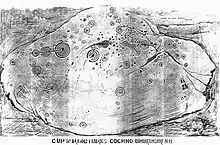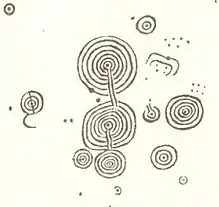Cochno Stone
The Cochno Stone is a large cup and ring marked rock at Auchnacraig, Faifley, West Dunbartonshire, Scotland,[1] next to the Cochno farm.[2] It is also known variously as "Whitehill 1"[3]:9 and "the Druid Stone".[3]:2

Sketch by W. A. Donnelly (dated 1895) of the Cup & Ring marks on the Cochno Stone. Published by John Bruce in 1896
The Bronze Age stone measuring 42 by 26 feet (12.8 by 7.9 metres) was documented in 1887 by the Rev. James Harvey.[3]:3 It features around 90 carved indentations, considered to be one of the finest sets of petroglyphs in Scotland.[4]

Detail sketched by James Harvey of Duntocher in 1889
The stone was reburied in 1965 to protect it against vandalism. In 2015 it was partially re-exposed for investigation during a 3-day dig by a team involving archaeologists from the University of Glasgow,[5] with a more complete re-exposure following a year later.[6]
References
- "Whitehill: Cup And Ring Marked Rock". Canmore. Historic Environment Scotland. Retrieved 5 August 2016.
- "Dig to unearth prehistoric Cochno Stone". BBC News. 7 September 2016. Retrieved 1 October 2017.
- Brophy, Kenneth (March 2018). "'The finest set of cup and ring marks in existence': the story of the Cochno Stone, West Dunbartonshire" (PDF). Scottish Archaeological Journal. 40 (1). doi:10.3366/saj.2018.0092. ISSN 1471-5767.
- Brown, Craig (17 July 2014). "5000-year-old Cochno Stone carving may be revealed". The Scotsman. Retrieved 5 August 2016.
- "Historic Cochno Stone uncovered by archaeologists". Clydebank Post. 17 September 2015. Retrieved 5 August 2016.
- "Fire crews fighting mud for Cochno Stone archaeologists". BBC News. 12 September 2016. Retrieved 12 September 2016.
External links
- "Site photograph: detail of markings". Canmore. Historic Environment Scotland. Retrieved 5 August 2016.
- Cochno on CANMORE, Historic Environment Scotland. Retrieved 6 October 2017.
- High-resolution image viewer of the Cochno Stone by Factum Foundation for Digital Technology in Conservation.
This article is issued from Wikipedia. The text is licensed under Creative Commons - Attribution - Sharealike. Additional terms may apply for the media files.